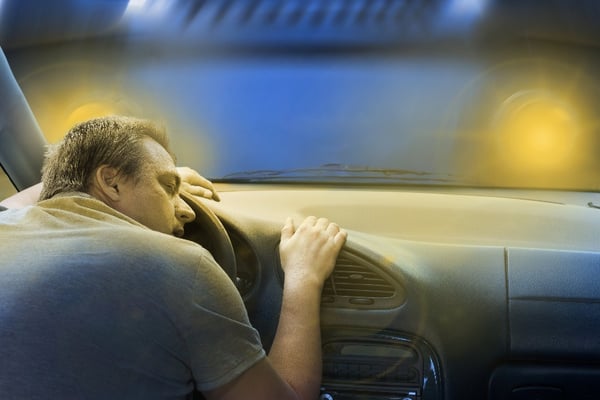
When you run a professional business fleet, the mental clarity of your drivers is an important part of your calculations. Naturally, you hire down-to-earth experienced professionals who take the job of driving seriously. But even a highly responsible person can be at-risk behind the wheel when exhausted.
Whether your drivers had a late night with an early morning shift or are working late on emergency calls, it's vital that you keep track of drowsiness and help your drivers avoid the risks when circumstances aren't ideal.
The problem is that drowsiness isn't just inconvenient. The effects of drowsiness behind the wheel are uncannily similar to those of drunk driving.
According to the National Sleep Foundation (NSF), being awake for 18 hours can simulate the equivalent of a 0.05 Blood alcohol level in terms of slow response time, inattentiveness, and distraction.
But we also know that long work days happen and your teams are dedicated to providing excellent work even if they're running low on energy.
So today, we're here to share a PSA of insights and tips that will help your business fleet consider and prevent the risks of drowsy drivers on late night jobs and unusual shifts.
Driving Drowsy Happens to Everyone
Adult drivers do the needful, which sometimes means driving when we're tired. Driving drowsy isn't something that people choose, it's something that happens to adults trying to be responsible even when they are tired. It happens when people sleep poorly but still go to work.
It happens when a shift goes late or an emergency comes up and driving is a necessity to handle the situation. According to the NSF, three out of every ten drivers admits that they have woken up on the road, thankfully still in their lane position.
Unfortunately, professional drivers are no exception. Exhaustion, late nights, poor sleep, and unusual shift times all increase the chances that drivers go through at least a period of drowsiness while behind the wheel and on the clock.
Keeping Your Team Safe from Drowsy Driving
The problem, of course, is that you can't choose when your team might be drowsy. Any responsible adult can choose not to drink if they know they are going to drive later on. This is an easy choice to make and your team would never come to work or get behind the wheel after a drink.
But there is no smart decision at noon that will keep someone from being sleepy by 10 if there's time for a nap.
Even fleets that only work during normal daytime hours may need to protect against drowsy driving. Employees don't always get a good night's sleep, for personal reasons ranging from new parents to overnight emergencies keeping them awake.
When drivers arrive for their shift after a poor night's sleep or under the weather, it's important to already have measures in place that can help recognize, avoid, and remedy drowsy driving.
Chances are that your drivers will be called on to drive on days and during hours when they may experience drowsiness both now and in the future.
Therefore, the smart approach is for every driver and team to have a collection of coping mechanisms to help them stay awake and alert behind the wheel.
Drowsy Driving Policies for Fleet Managers
Think carefully about the drowsy driving risks of your fleet, industry, and drivers and build a set of policies to keep your drivers safe.
Learn to recognize the warning signs of drowsy driving and be sure to train your drivers (and non-driving team members) to recognize when a driver has begun to lose focus.
Join us next time for the second half of this PSA article where we'll share eight smart tips on how to recognize, avoid, and remedy drowsy driving.
You can spring-board off these basic tips to form a custom plan for your fleet to keep everyone safe from the dangers of drowsy driving. Contact us today for more fleet management insights, tips, and the tools you need to thrive as a commercial fleet.
[Continued in Part 2]








